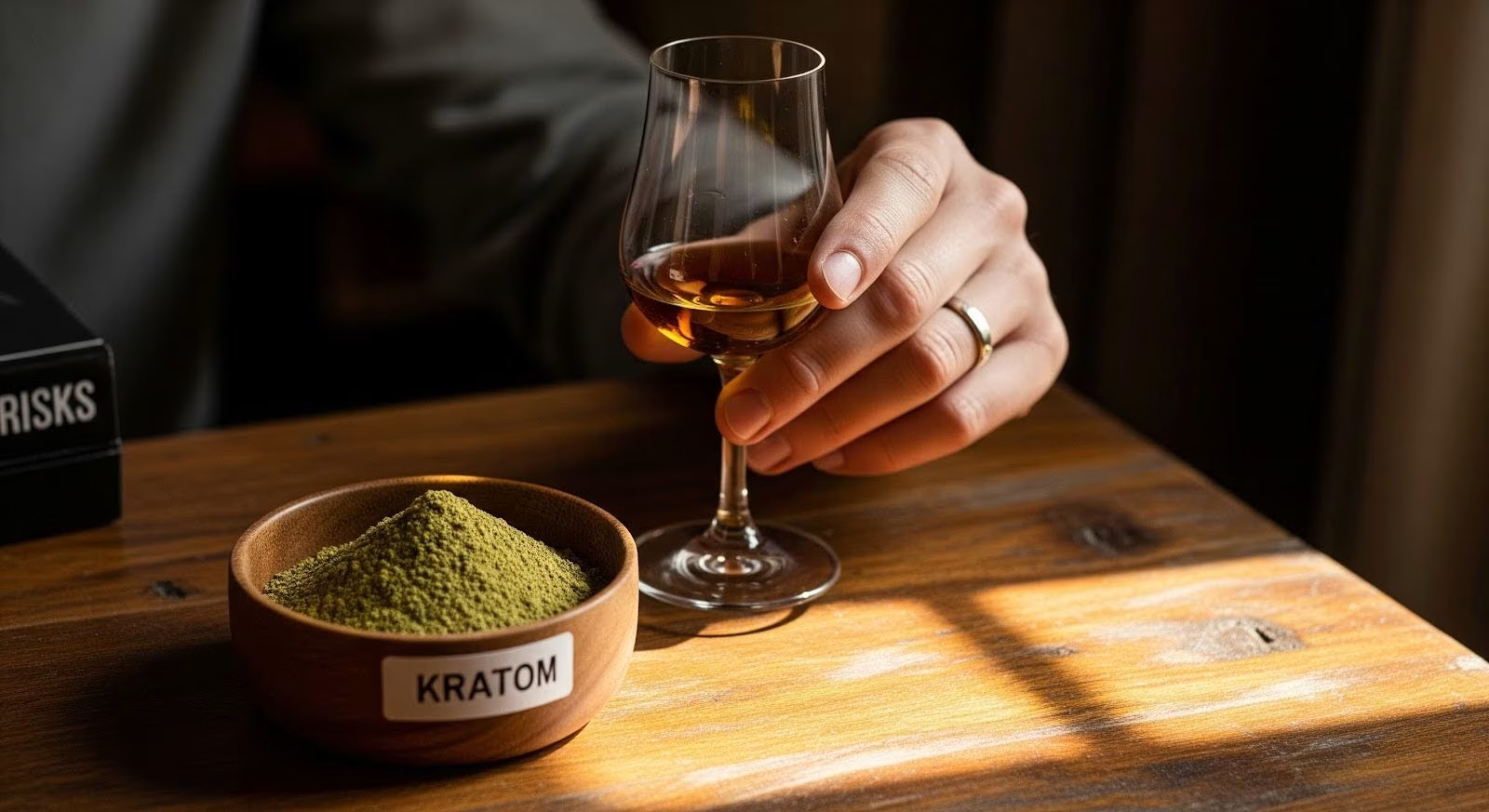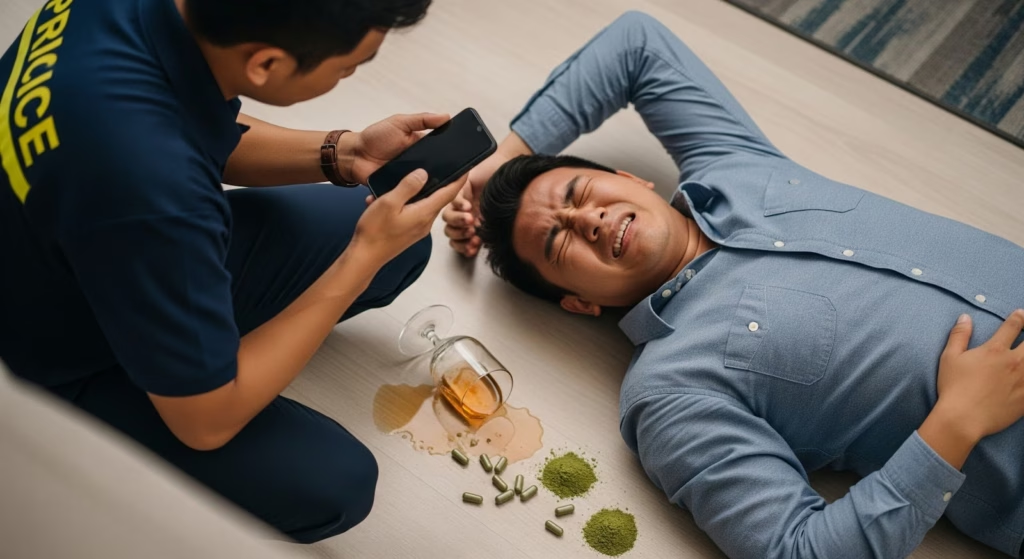
Mixing substances always raises safety questions, especially when one acts like an opioid and the other is a common depressant.
Based on current evidence, it is not safe to drink alcohol while taking kratom because the combination materially increases risks of sedation, respiratory depression, impaired coordination, and serious medical outcomes within hours of co-use.
This article explains why these two substances create a dangerous overlap, what the research shows about short-term side effects, and what harm reduction steps matter most if you or someone you know uses both.
Can You Drink Alcohol With Kratom?
No, you should not drink alcohol with kratom. Kratom’s primary alkaloids, mitragynine and 7-hydroxymitragynine, are partial mu-opioid receptor agonists that produce sedative and opioid-like effects at higher doses.
Alcohol is a central nervous system depressant that impairs breathing and coordination. When combined, these effects stack in the first one to six hours after intake, creating additive or supra-additive risks.
Poison center data consistently show that kratom exposures involving other substances result in markedly higher ICU admissions: 28.3 percent with co-exposures versus 8.6 percent for kratom alone.
Alcohol is one of the most frequently reported co-ingestants in kratom-related calls, and the CDC has emphasized that severe adverse effects occur especially when kratom is consumed with alcohol or other drugs.
Even though controlled human studies directly testing kratom and alcohol together do not yet exist, the convergence of mechanistic pharmacology, clinical toxicology, and real-world surveillance supports a clear recommendation to avoid this combination.
How Kratom and Alcohol Interact in Your Body?
Kratom’s alkaloids reach peak blood levels about one to two hours after you take tea, powder, or capsules.
Human pharmacokinetic studies show mitragynine has a median time to maximum concentration of roughly one hour, with some alkaloids peaking later and producing multiple concentration waves over the first 12 hours. Alcohol absorption is faster, typically peaking within 30 to 90 minutes after drinking.
This overlapping timeline means the highest combined effect happens in the first few hours. During that window, both substances are working on your brain and body at once.
Kratom acts on opioid receptors and adrenergic pathways, producing sedation and pain relief at higher doses. Alcohol enhances inhibitory neurotransmission and suppresses excitatory signaling, leading to drowsiness, slowed reflexes, and impaired breathing.
Animal research indicates that ethanol’s behavioral effects are modulated by mu and delta opioid receptors, the same systems kratom alkaloids target.
This receptor-level overlap suggests that co-use can amplify sedation beyond what either substance produces alone, especially as doses increase or in people without tolerance.
Mitragynine also has a long elimination half-life. After repeated daily dosing, it can take eight to nine days to reach steady state, meaning kratom remains in your system for days.
If you drink alcohol even 24 hours after your last kratom dose, you may still have meaningful kratom levels circulating, extending the risk window far beyond the initial intake.
Short-Term Risks of Mixing Kratom With Alcohol
The acute side effects of combining these substances cluster in predictable categories, all emerging within the first several hours:
Central nervous system effects include pronounced sedation, dizziness, confusion, and slowed reaction times. While regular kratom users at self-selected doses show minimal driving impairment when sober, adding alcohol erodes that safety margin. You become more likely to misjudge distances, drift lanes, or fall asleep at the wheel.
Respiratory depression is a serious concern. Alcohol suppresses breathing at higher blood alcohol concentrations, and kratom’s opioid-like activity can do the same, particularly with potent alkaloid profiles or higher doses.
Although mitragynine shows biased agonism that may reduce respiratory risk compared to morphine, the addition of alcohol creates plausible additive effects. Shallow or slow breathing, especially if you are alone or lying down, can lead to dangerous oxygen levels and loss of consciousness.
Cardiovascular symptoms such as rapid heart rate and elevated blood pressure appear frequently in poison center reports. About 25 percent of kratom exposure calls documented tachycardia, and 11.7 percent noted hypertension.
Alcohol can initially cause vasodilation and reflex tachycardia, then shift toward hypotension as sedation deepens. The combination may produce palpitations, chest discomfort, or dizziness when standing.
Gastrointestinal distress is common with both substances. Nausea and vomiting occurred in nearly 15 percent of kratom cases in CDC surveillance.
When you are also sedated from alcohol, vomiting becomes an aspiration risk. If you lose airway reflexes or lie on your back, stomach contents can enter your lungs, causing pneumonia or acute respiratory failure.
Agitation and mood instability can emerge, especially in mixed-effect contexts where kratom produces stimulant-like effects at lower doses and alcohol causes disinhibition.
About 24 percent of poison center calls involved agitation or irritability. Emergency departments often use benzodiazepines to manage these symptoms, but the underlying risk is preventable by avoiding co-use.

Why Does the Timing Window Matters?
Understanding when peak effects occur helps you grasp why separation by a few hours is not enough protection. Kratom alkaloids show complex absorption patterns.
Some reach maximum levels within an hour, while others continue rising through two to four hours. If you drink during this same stretch, blood alcohol rises while kratom levels are climbing or plateauing, maximizing the overlap.
Ecological momentary assessment studies found that regular users report feeling kratom’s effects within 15 to 180 minutes. If you take kratom in the evening and start drinking an hour later, you hit both peaks together.
Even if you wait several hours between kratom and alcohol, mitragynine’s prolonged half-life means residual sedation persists, and adding alcohol reintroduces depressant effects on top of that baseline.
Formulation also matters. Tea may be absorbed slightly faster than encapsulated powder, and extracts or concentrates deliver higher alkaloid loads in smaller volumes.
The unpredictability of kratom products, which vary widely in mitragynine and 7-hydroxymitragynine content, makes it nearly impossible to calculate a safe drinking interval. Without standardized dosing or labeling, users cannot reliably estimate when their system is clear.
Clinical Evidence and Poison Center Data
Real-world data provide the strongest signal that co-use increases harm. Between 2010 and 2015, U.S. poison centers saw a tenfold increase in kratom exposure calls.
Among those, about 35 percent involved multiple substances, and ethanol was among the most common co-ingestants alongside benzodiazepines, narcotics, and acetaminophen.
Outcomes in these cases were not trivial. Minor effects occurred in 24.5 percent, moderate in 41.7 percent, and major in 7.4 percent, including one death where multiple pharmaceuticals were also present.
When researchers examined Georgia and Alabama poison center calls, they found that kratom exposures with any co-ingested substance had more than three times the ICU admission rate compared to kratom alone.
Postmortem investigations tell a similar story. Among 152 overdose deaths where kratom was detected, nearly all had coingestants.
While cause attribution is complex and alcohol-specific data are not isolated, the pattern is consistent: polysubstance contexts drive severe outcomes.
Emergency departments report a spectrum of presentations. A 2025 clinical review emphasized that kratom-related visits range from mild tachycardia and agitation to seizures, respiratory depression, and hepatotoxicity.
Management is primarily supportive, with benzodiazepines for agitation or seizures and close respiratory monitoring. The lack of standardized kratom testing complicates diagnosis, and clinicians must often rely on history and symptom patterns to identify co-use.
A latent class analysis of national survey data found that most past-year kratom users also used alcohol, often in combination with marijuana and tobacco.
Among individuals reporting lifetime kratom use, 17.8 percent met criteria for past-year alcohol use disorder, more than triple the rate among never-users. This co-occurrence underscores the clinical importance of screening for alcohol when evaluating kratom-related concerns.
Who Faces the Highest Risk?
Not everyone who mixes kratom and alcohol will have the same outcome, but certain factors stack the odds toward serious harm:
- Inexperienced users lack tolerance to either substance. What a regular kratom consumer handles without impairment can cause profound sedation in someone trying it for the first time, especially with alcohol on board.
- High doses or potent products increase risk. Extracts, concentrates, or products with elevated 7-hydroxymitragynine shift effects toward stronger opioid-like sedation and respiratory depression.
- Binge drinking patterns that push blood alcohol above moderate levels amplify all central nervous system effects and respiratory risks.
- Concurrent depressants such as benzodiazepines, prescription opioids, gabapentinoids, or even over-the-counter antihistamines create triple or quadruple stacking, dramatically raising the chance of respiratory failure or loss of consciousness.
- Underlying health conditions such as liver disease, sleep apnea, chronic obstructive pulmonary disease, or cardiovascular problems reduce physiologic reserve. Acute co-use can tip vulnerable individuals into symptomatic distress or medical emergency.
- Lack of supervision means no one is present to notice shallow breathing, vomiting, or unresponsiveness. Many adverse outcomes occur when people are alone or in settings where help is delayed.
The FDA has stated that kratom is not reasonably expected to be safe as a dietary ingredient and carries risks of respiratory depression, hallucinations, and multi-organ toxicity. These warnings apply to kratom alone; adding alcohol compounds every concern.

What If You or Someone You Know Uses Both?
The evidence-based recommendation is clear: avoid mixing kratom with alcohol. If you choose to use kratom, do not drink, and vice versa. However, if co-use occurs or you are supporting someone who uses both, harm reduction principles can reduce short-term risk:
- Minimize doses of each substance. Lower amounts mean less overlap at peak effect. Do not assume your usual dose is safe when adding alcohol.
- Maximize time separation. Even though mitragynine lingers for days, spacing intake by at least several hours reduces the peak co-effect. Ideally, avoid alcohol entirely on days you use kratom.
- Never drive or operate machinery for at least six hours after co-use, and longer if you feel any impairment. Reaction times, judgment, and coordination are all compromised.
- Avoid all other central nervous system depressants, including benzodiazepines, opioids, sleep aids, and sedating antihistamines. Each additional agent multiplies risk.
- Stay hydrated and avoid lying flat if you feel nauseated. Sitting upright reduces aspiration risk if vomiting occurs.
- Have a sober companion present who can monitor for slow or shallow breathing, confusion, or unresponsiveness and call for help if needed.
- Seek immediate medical attention for any of these signs: respiratory rate below 10 breaths per minute, inability to stay awake, repeated vomiting, seizure activity, chest pain, or severe confusion.
Clinicians should ask explicitly about kratom and alcohol use in patients presenting with unexplained sedation, agitation, or mixed toxicity.
Standard toxicology panels do not detect kratom alkaloids, and some co-ingestants such as 2-methyl-2-butanol also evade routine screens. High clinical suspicion and detailed substance use history are essential.
For individuals struggling with frequent co-use, polysubstance patterns, or alcohol use disorder, evidence-based treatment offers a path to stability and reduced harm.
Addressing the underlying reasons for use, whether pain, mood symptoms, or dependence, is more effective than managing each acute crisis individually.
The Bottom Line on Kratom and Alcohol
Kratom and alcohol should not be combined. The pharmacologic overlap, real-world toxicity data, and absence of controlled safety studies all point in the same direction: co-use materially elevates risks of sedation, impaired psychomotor function, respiratory depression, and medical complications within hours of intake.
While kratom alone may carry lower intrinsic respiratory risk than classical opioids due to biased agonism, that margin disappears when alcohol enters the equation. Poison center patterns show that any co-exposure with kratom increases the likelihood of ICU admission and serious outcomes.
The unpredictability of kratom product potency, individual tolerance, and the long half-life of mitragynine make even “careful” co-use strategies unreliable.
If you currently use kratom for pain, energy, or managing withdrawal and also drink alcohol, consider the acute window of greatest danger as the first few hours after either intake. Recognize that repeated daily kratom use creates persistent drug levels that interact with alcohol consumed days later.
And understand that the clinical presentations of co-use range from mild discomfort to life-threatening respiratory failure, often in unpredictable ways.
The research is clear enough to warrant a precautionary stance. Until direct human coadministration trials clarify dose-response relationships and identify any theoretical safe margins, the evidence-aligned position is avoidance.
For those unable or unwilling to stop co-use, strict harm reduction and clinical engagement become essential to prevent preventable tragedy.
If you or a loved one is navigating polysubstance use involving kratom, alcohol, or other depressants, you do not have to manage it alone. Reach out to Thoroughbred Wellness and Recovery for alcohol addiction treatment that can address substance use with compassionate, evidence-based care.
Taking that step can be the difference between repeated crises and lasting freedom.









